At its Annual Meeting on July 19, 2023, Rutland County Audubon marked the 50th anniversary of its founding . Roy Pilcher, who attended that initial meeting in 1973, spoke about the personalities involved in those early days, and about memorable birding events he has experienced over that half century.
Pitz-aa!
Pitz- aa! The sound explodes in the air and you look up just in time to glimpse a tiny bird darting through dense branches and (alas!) diving out of sight.
What was that? You probably didn't catch enough of the diminutive body to identify him, but that loud, splintery call gave him away. That was the Acadian Flycatcher which visited Sudbury for a few weeks, seemingly following the Otter Creek's flooding of Route 73 this past month and attracting birders from all over the state.
The ACFL is a relative of Vermont's more common flycatchers, such as the Willow, Alder, and Least, all members of the Tyrannidae or Tyrant Flycatcher family known for their fierce insect-catching prowess.
The Acadian breeds in the Eastern US and Southern Canada in dense deciduous forests located near rivers, brooks, or other wetlands. He winters in sunnier climes, as far away as South America.
If seen up close, he has olive green uppers, a white breast, a distinct eye ring, and bold wing bars. Like a Hummingbird, he can hover and even fly backwards, making it easier for him to surprise his prey.
The ACFL's stay in Rutland County was too short, but long enough for many birders to now recognize that explosive call. If you should hear it, grab your binocs as fast as you can or you may not get a chance to go eyeball to eye ring with this amazing bird.
Kathleen Guinness, author
Photo by Sue Wetmore
Rutland County Audubon Annual Meeting
July 19, 2023
Rutland County Audubon will hold its Annual Meeting on Wednesday, July 19, 2023, at the Proctor Free Library in Proctor, Vermont at 6 p.m. We will begin with a potluck dinner, followed by the meeting, which includes the installation of officers.
All members and friends are invited to attend this, the 50th anniversary of RCAS. Dessert, beverages and utensils will be provided.
Please join us!
Whipple Hollow Trail
by Roy Pilcher
On Monday, May 29, I had the opportunity of walking part of the Whipple Hollow Trail for the first time starting at the trail head. My walking difficulty only allowed me to reach the edge of the McCullough meadow after about 35 minutes. But what a wonderful experience!
The chorus of Northern Waterthrush, some counter singing only to be interrupted by the cry of a Great Crested Flycatcher was music to my ears! I did manage to identify twelve bird species all by ear. Ears and eyes are holding up better than my legs after 94 years of sustained activity!
The boardwalk is a masterpiece. I enjoyed the access to the flowering plants that included Marsh Marigold, Heartleaf Foamflower, Golden Alexander and Miterwort.
Twoleaf Miterwort, Mitella dipyllaI observed a Mourning Cloak, the only butterfly. However, the wetland beyond and the meadow should prove excellent butterfly habitat, especially for Mulberry Wing Skipper and Baltimore Checkerspot, especially during this second butterfly atlas.
Congratulations to you and the board for your efforts in providing access to this magnificent wildlife habitat. I cannot imagine any serious birder or naturalist in Vermont not having West Rutland on his/her bucket list between the Marble Street, Whipple Hollow and the power line habitats.
Note from RCAS: Click here to see all the birds we have seen along the Whipple Hollow Trail.
West Rutland Marsh Monitoring
A frosty May morning turned into a perfect day at West Rutland Marsh.
With starting temperatures in the 30s, May’s walk certainly didn’t start out feeling much like spring, but sunny skies and warming turned it into a perfect day at West Rutland Marsh.
Despite not hearing a Virginia Rail or an American Bittern (one person heard a bittern before the official start of the walk), ten participants managed to tally 82 species. This doesn’t include the Blue-winged/Golden-winged Warbler, which we could only identify by sound (neither of these species are reliable voice alone as they can frequently sound like each other and there are many hybrids) along with a falcon, not identified to species.
The morning started off with Marsh Wrens and Swamps Sparrows singing all around the boardwalk. The Alder Flycatchers returned within the past few days and today was the first time hearing Willow Flycatchers for many of us this season.
A Spotted Sandpiper was standing on the railing of the boardwalk and soon after that a Green Heron flew over, landing and disappearing nearby.
This may be shaping up to be a good year for cuckoos. Four Black-billed Cuckoos were heard and we saw plenty of tent caterpillars for them to eat.
Raptors included a Broad-winged Hawk, a Red-tailed Hawk and a falcon we could identify, a Merlin.
May is warbler month! We tallied 16 species including Tennessee and Bay-breasted. We were fairly sure we heard the Bay-breasted Warbler high in the trees along the Whipple Hollow Trail (it was identified by the Merlin ID app as well). Finally, perseverance paid off and some of us saw enough of the bird to confirm its presence visually. Northern Waterthrushes were singing enthusiastically especially along the Whipple Hollow Trail.
Our next marsh walk is scheduled for Saturday, June 20, at 7 a.m., meeting at the Marble Street boardwalk.
A complete list of today’s birds can be found here.
Trip Report: Female Bird Walk
by Joel Tilley
RCAS held a Female Bird Walk at the West Rutland Marsh on a sunny (if windy) Saturday, May 13. Six people participated. We began by talking about the visual, audible, and behavioral clues to identifying female birds of many species, as well as the need for more research into female bird behavior (especially on their wintering grounds).
american redstart
A male American Redstart sings to attract or impress his female partner.
We listened to some recorded songs of female birds: some are very similar to the male songs (Baltimore Oriole, Northern Cardinal) while some are distinct to the females (Mallard, Red-winged Blackbird). Out of 54 species observed, we were able to positively identify females in nine:
- Mallard (brown overall, quacks, while male sort of grumbles)
- Northern Harrier (reddish brown, compared to gray males)
- American Kestrel (reddish wing coverts, vs blue-gray on males)
- American Goldfinch (greenish-yellow, lacks black cap of male)
- Red-winged Blackbird (brown striped, sings distinctive clattering song)
- Brown-headed Cowbird (overall brown)
- Common Grackle (smaller body, shorter tail than male - best seen when the two are together)
- Yellow Warbler (lacks reddish stripes on breast)
- Northern Cardinal (buffy brown tinged with red)
As the breeding season progresses, more females should become visible as they gather food for hungry chicks. Then in the late summer and fall, it gets more confusing, as many immature birds have the same plumage as adult females, and some adult males molt to more subdued plumage. Have a great summer of birding!
Winter Returns! - February West Rutland Marsh Walk
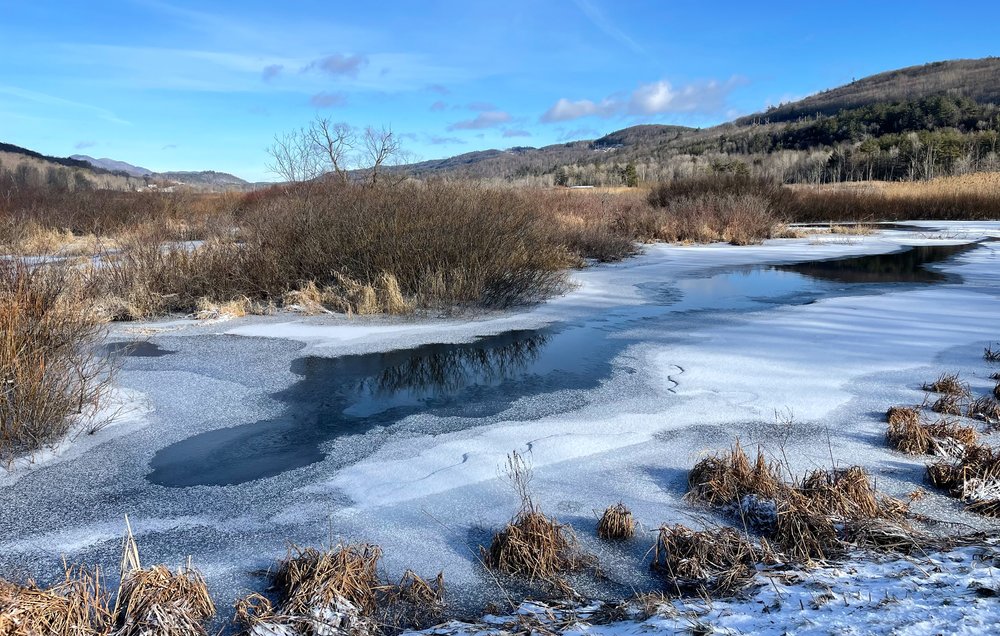
Winter returned after a brief break for today’s walk around West Rutland Marsh with a chilly temperature and light wind. Twelve observers tallied 19 species. The walk was held in conjunction with this weekend's Great Backyard Bird Count which runs through Monday.
Red-winged Blackbirds returned to Vermont this week. Two were at the feeding station by the boardwalk on Marble Street. We also heard them singing ‘klonkaree.’ Northern Cardinals and Tufted Titmice were also singing.
The only raptor of the day was a Red-tailed Hawk soaring above the marsh and up toward the ridgeline.
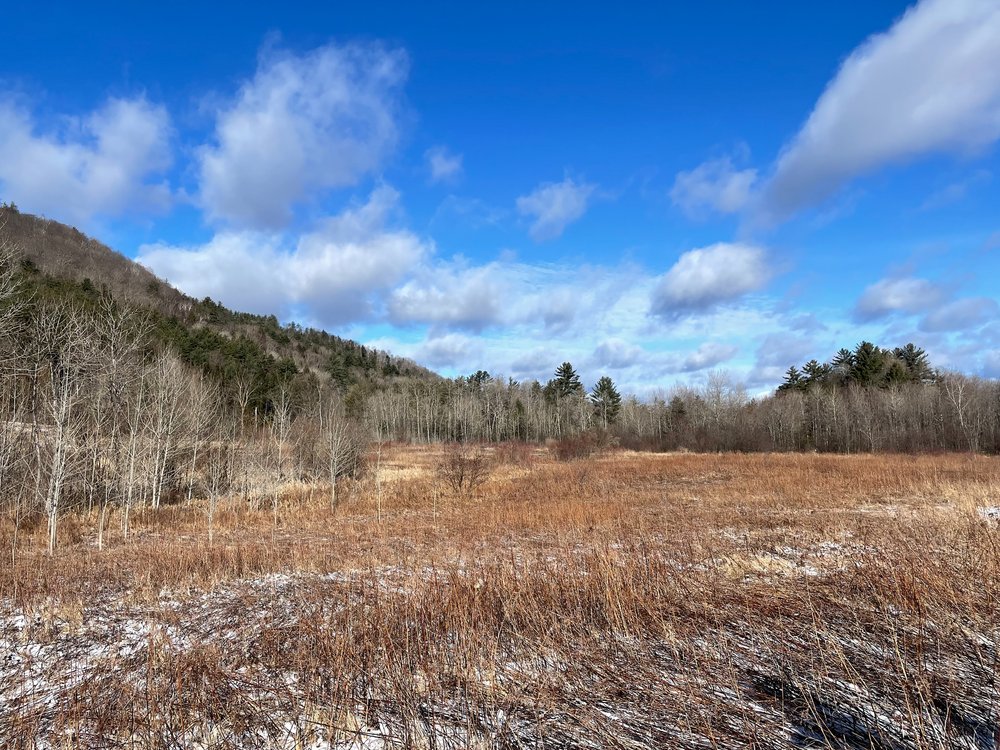
Eastern Bluebirds were seen feeding on sumac. Only two American Tree Sparrows were observed and one Dark-eyed Junco.
Seven Downy Woodpeckers were seen and one Pileated Woodpecker was heard.
A complete list of today’s species can be found here.
Our next marsh walk is scheduled for Thursday, March 16, at 8 a.m.
West Rutland Marsh - January 2023
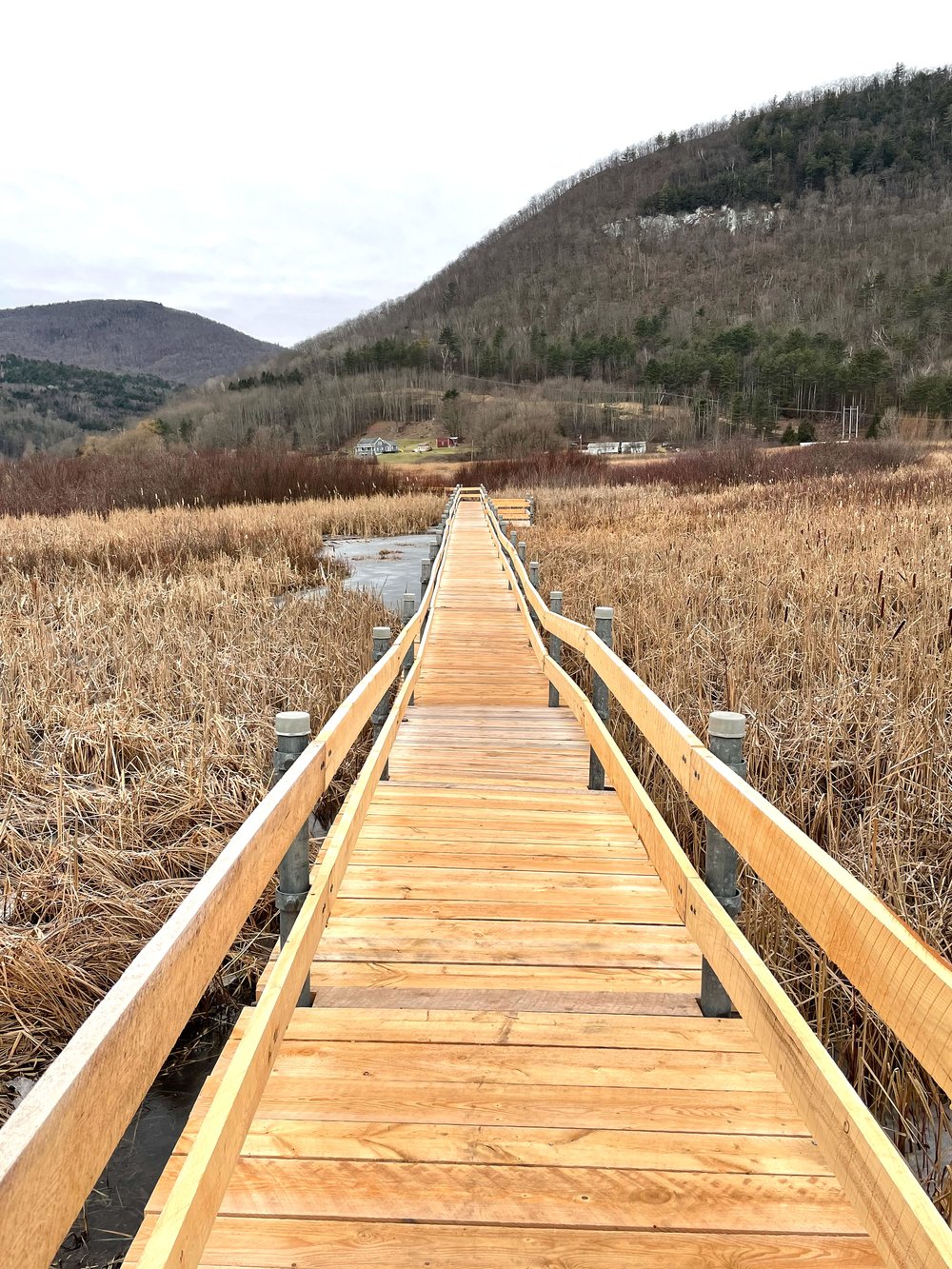 No snow and mild temperatures! Today’s walk around West Rutland Marsh seemed more like a day in November rather than mid-January. Seven participants tallied 21 species, none of them a surprise and none of the winter irruptives being seen sporadically elsewhere in the state.
No snow and mild temperatures! Today’s walk around West Rutland Marsh seemed more like a day in November rather than mid-January. Seven participants tallied 21 species, none of them a surprise and none of the winter irruptives being seen sporadically elsewhere in the state.
The feeders on Marble Street (next to the newly refurbished boardwalk) were busy with a Downy Woodpecker, Black-capped Chickadees, a Tufted Titmouse, White-breasted Nuthatches, American Tree Sparrows and a Northern Cardinal. An American Robin was heard across the way.
The birds were more vocal than they were a month ago and woodpeckers were heard drumming, not a surprise with the lengthening days.
Further down the road we heard a Carolina Wren calling.
The Whipple Hollow Trail was very quiet with only a chickadee and a Ruffed Grouse flushed.
Our next walk is Saturday, February 18, 8 a.m., scheduled to coincide with the Great Backyard Bird Count.
Click here for a full list of today's birds.
Rutland County Audubon's 49th Christmas Bird Count
 As the days get longer and the temperature drops to single digits, birding may seem less exciting. But not to birders during Christmas Bird Count season! The results from the 2022 Christmas Bird Count are in. This was our 49th annual count and National Audubon's 123rd.
As the days get longer and the temperature drops to single digits, birding may seem less exciting. But not to birders during Christmas Bird Count season! The results from the 2022 Christmas Bird Count are in. This was our 49th annual count and National Audubon's 123rd.
In addition to our field teams, we have a number of folks doing feeder counts. It’s a lot of work to organize and compile, but the more data we have the better indicator it is of the bird populations for our local area. The reason for the counts is just that - to check on the status of bird populations.
We express a sincere thank you to all field observers and feeder watchers. Your efforts are vital to Rutland County Audubon’s continued mission to preserve and protect birds and their habitats. And have a good time doing it!
Now the review:
The weather this year was even milder than the warm weather we have experienced in the last several years. There was no snow cover and the wind was variable between 5 and 15 miles per hour. The temperature ranged from 38 degrees and 46 degrees. Compared to some past years it was balmy. So how did it affect our bird count?
 Golden EagleIn 2022 we tallied 54 species and counted a total of 4,473 individual birds. Looking back at ten years this is a low numbers for individuals. This year’s species count includes three Count Week birds, birds not seen on count day, but on either the three days prior or three days following the count. The number of birds seen may be related to weather. Mild weather and no snow may mean birds are more dispersed to locations where food is available rather than being present along cleared roadsides and at fields. You’ve probably noticed that your feeders are busier when it is cold and snowy.
Golden EagleIn 2022 we tallied 54 species and counted a total of 4,473 individual birds. Looking back at ten years this is a low numbers for individuals. This year’s species count includes three Count Week birds, birds not seen on count day, but on either the three days prior or three days following the count. The number of birds seen may be related to weather. Mild weather and no snow may mean birds are more dispersed to locations where food is available rather than being present along cleared roadsides and at fields. You’ve probably noticed that your feeders are busier when it is cold and snowy.
So here are a few comparisons to the past ten years:
Wild Turkey: 205 this year compared to a high of 227 in 2018
Red-bellied Woodpecker: 16 compared to a high count of 17 also in 2018
Black-capped Chickadee: 460 birds compared to a high of 868 in 2013.
Eastern Bluebird: 63 compared to a high count of 85 in 2019. Last year was second highest in the period.
New Count Species Every year we wait somewhat impatiently to hear if a species was seen that was not seen during prior counts. This year we had none, but there were some highlights nevertheless.
Raptors were well-represented in this year’s count: Golden Eagle, Bald Eagle, Cooper’s Hawk, Northern Goshawk, Red-shouldered Hawk, Red-tailed Hawk and Rough-legged Hawk, American Kestrel, Merlin, Peregrine Falcon and Barred Owl.
Northern Flickers are becoming more common in winter and this year we also had a Yellow-bellied Sapsucker.
Sparrow numbers were fairly low and included American Tree Sparrow (37), Dark-eyed Junco (140), White-throated Sparrow (4) and Song Sparrow (1). A Savannah Sparrow was a nice addition to the count.
Although some winter irruptive species, have arrived in Vermont this winter (Evening Grosbeak, Pine Grosbeak, Bohemian Waxwing, Pine Siskin and Common Redpoll), only Pine Grosbeaks were seen during our count with a total of 13 seen.
Yes, effort counts. Maybe next year we will find other surprises. For new birders the time to start preparing is now by feeding birds and learning to ID them. Learn eBird to record the results. Build some time in your life to enjoy nature and contribute to the lifelong need to protect bird habitat starting with your own backyard. If you need help or have questions email us at (add link) enough people are interested, we could do a program in the fall to explain a bird count that is over 100 years old and to learn to ID birds.
Click here for a link to National Audubon’s database of Christmas Bird Count historical results.
by Marv Elliott
Rutland County Audubon CBC results:
Duck, Duck, Coot!
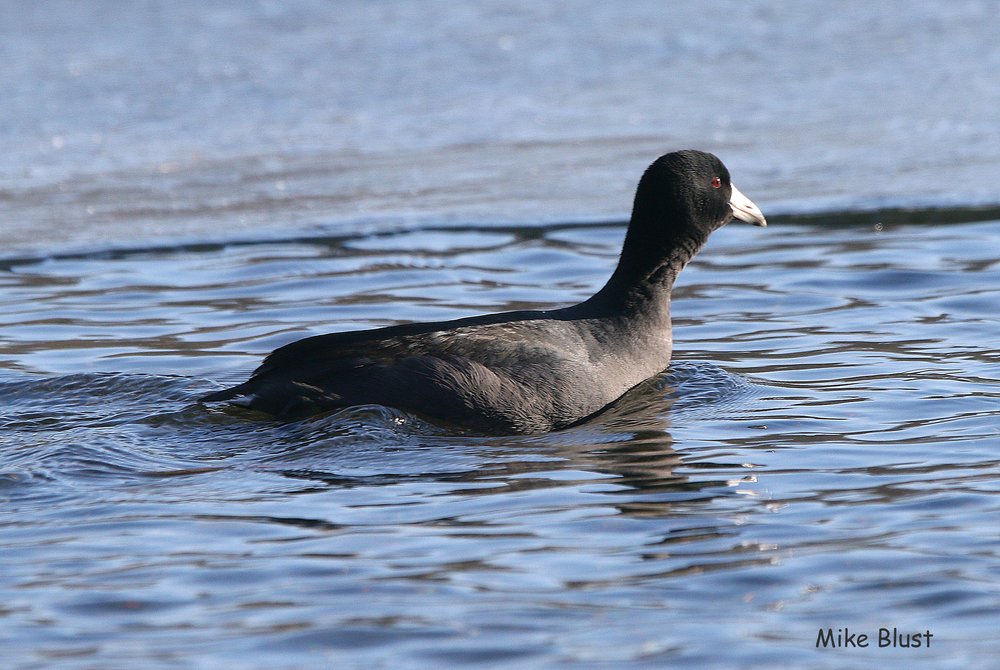 It seems that nearly every season RCAS birders delightedly spy an unusual or rare bird in our area. Last summer, the mid-western Sedge Wren caused a big stir in the meadow off our new Whipple Trail in West Rutland. This winter, an American Coot, or actually two coots, arrived at Lake Bomoseen, making the birding news and causing birders to rush to get a gander at them.
It seems that nearly every season RCAS birders delightedly spy an unusual or rare bird in our area. Last summer, the mid-western Sedge Wren caused a big stir in the meadow off our new Whipple Trail in West Rutland. This winter, an American Coot, or actually two coots, arrived at Lake Bomoseen, making the birding news and causing birders to rush to get a gander at them.
What's a coot and what makes it so special? Although it looks very much like a duck and seems to swim like a duck, it doesn't quack like a duck nor does it fly like a duck. This is because it's not a duck, but a member of the Rallidae or rail and crane family. What you can't see when you're eagerly viewing it through your binocs, is that it has long legs, ending in something resembling flippers, rather than the webbed feet of a duck. Because of these legs, it needs a large expanse of water in which to become airborne.
Coots summer in the northern U.S. from central New York west through the plains’ states and Canada, but are also found year-round in the western and south-central U.S. and into Mexico. There is only one confirmed breeding record in the first Atlas of the Breeding Birds of Vermont - a brood of young seen in Alburg during the first atlas and none found in the second atlas. Interestingly, according to the first Atlas of the Breeding Birds of Vermont, the only pre-atlas record of nesting was in 1904 at Lake Bomoseen. In winter, coots gather in large flocks, called commotions or swarms, where they feed in water-covered rice fields and wetlands and are sometimes being considered a nuisance. In any season they are not common in Vermont.
So, what are these two striking birds with gray bodies, darker heads and white beaks doing on Lake Bomoseen now? We can't be sure but think they somehow became separated from their swarms on their trip south and found shelter here where there is, for this time of year, an unusual amount of open water and enough vegetation on which they can feed to keep them satisfied. They're devouring stems, leaves, seeds, and even algae as they cruise the bays, while we happily gawk at them and snap pictures.
Will they stay all winter? It is unlikely as the lake freezes, they will probably say, ‘coot, coot, coot’ and head to their usual winter havens. We can only hope the coots will remember our waters as they move to their breeding grounds again in spring. Stay tuned or, better yet, get a peek at one or both while you can.
Check out the boardwalk and beach at Bomoseen State Park or watch along the west side of the lake just south of the Kehoe Fishing Access.
West Rutland Marsh - December 2022
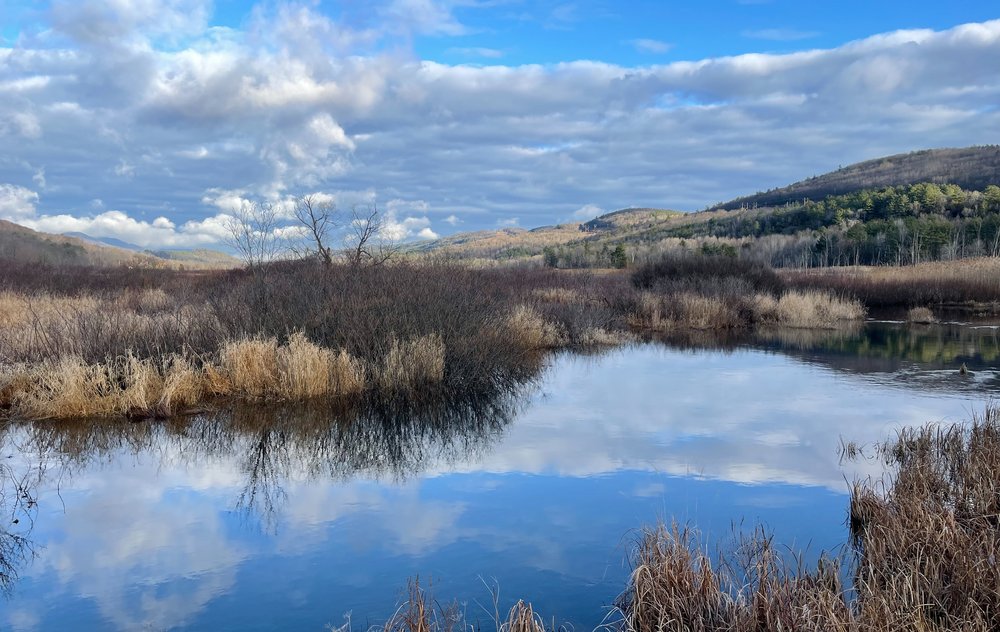 Six birders tallied 27 species during the December 2022 walk around West Rutland Marsh. No snow, no ice and a higher than normal temperature made the walk a bit un-Decemberlike.
Six birders tallied 27 species during the December 2022 walk around West Rutland Marsh. No snow, no ice and a higher than normal temperature made the walk a bit un-Decemberlike.
Waterfowl consisted of Canada Goose, American Black Duck and one Common Merganser.
Two raptor species were seen: Bald Eagle, an immature circling over the ridge, and a Cooper’s Hawk over the meadow along the Whipple Hollow Trail.
The walk opened with two Carolina Wrens singing along Marble Street. Further down the road a small flock of Eastern Bluebirds was seen and a flock of American Robins flew overhead.
A late Swamp Sparrow was observed at the end of the Marble Street boardwalk. That, along with American Tree Sparrow and Dark-eyed Junco, represented the sparrows.
A full list of the species seen can be found here.
Our next walk is scheduled for Thursday, January 19, 8 a.m.
West Rutland Marsh - November 2022
 Five people made the trek around West Rutland Marsh this morning with the results about what you would expect for mid-November. A total of 20 species was observed. Snow flurries accompanied us for the first half the trip, but fortunately there was no wind.
Five people made the trek around West Rutland Marsh this morning with the results about what you would expect for mid-November. A total of 20 species was observed. Snow flurries accompanied us for the first half the trip, but fortunately there was no wind.
Two female Common Mergansers were floating in the open portion of water (yes, ice is forming).
Four woodpecker species were tallied: Red Bellied, Downy, Hairy woodpecker as well as two Northern Flickers.
A dozen American Robins were seen on Marble Street.
Two Golden-crowned Kinglets were observed flitting in the hemlocks along Whipple Hollow Road.
Sparrows consisted of two Dark-eyed Juncos and one White-throated Sparrow.
Our next walk is scheduled for Thursday, December 8 at 8 a.m.
A complete list of what we saw can be found here.
West Rutland Marsh - October 2022
 RCAS’s October monitoring walk around West Rutland Marsh started on a cold note – one of the few chilly mornings we’ve had despite being well into October. Clear skies, low wind and the rising sun made the morning more pleasant as we went on.
RCAS’s October monitoring walk around West Rutland Marsh started on a cold note – one of the few chilly mornings we’ve had despite being well into October. Clear skies, low wind and the rising sun made the morning more pleasant as we went on.
Eleven participants tallied 27 species, about normal for this time of year. The first half of the walk was fairly quiet as was the Whipple Hollow Trail, but, overall, the second half of the walk was the ‘birdiest’ no doubt due to the sun and warming temperature.
Most of the observations on the walk were of the ‘usual suspects’ including Black-capped Chickadees, Tufted Titmice, White-throated  Sparrows and Dark-eyed Juncos. One Song Sparrow and three Swamp Sparrows were seen or heard.
Sparrows and Dark-eyed Juncos. One Song Sparrow and three Swamp Sparrows were seen or heard.
Two Gray Catbirds were spotted along Whipple Hollow Road.
While nowhere near as large as in past years, a large number of Red-winged Blackbirds and, to a lesser extent, Common Grackles, flew over.
No raptors or Turkey Vultures were seen.
A full tally of what we saw can be found here.
Our next marsh walk is scheduled for Thursday, November 17, at 8 a.m.
West Rutland Marsh - September 2022
 After being rained out last week, Rutland County Audubon managed to complete September’s monitoring of West Rutland Marsh before month-end. Five people tallied 44 species despite the cloudy and somewhat windy weather.
After being rained out last week, Rutland County Audubon managed to complete September’s monitoring of West Rutland Marsh before month-end. Five people tallied 44 species despite the cloudy and somewhat windy weather.
After some of us remarked on the low number of raptors we’ve seen this month, we ended up seeing Sharp-shinned Hawk, Cooper’s Hawk, Red-tailed Hawk and American Kestrel.
All the expected woodpecker species were seen: Yellow-bellied Sapsucker and Northern Flicker as well as Red-bellied, Downy, Hairy and Pileated woodpeckers.
Despite the prior day’s reports of warblers around the state, we only saw three species and only one each of those. They were Nashville Warbler, Common Yellowthroat and Yellow-rumped Warbler.
There was a higher number of sparrow species. They included Chipping, White-crowned, White-throated, Swamp and Song. Two, Dark-eyed Juncos, sometimes nicknamed snowbirds, were seen in a yard. No doubt we will be seeing more of those in the months to come.
 There was a high number of sparrows, including this Song Sparrow seen at West Rutland Marsh on Sept. 29, 2022The birding along the Whipple Hollow Trail was slow, but a Ruffed Grouse was observed near the spot where it was seen on past walk.
There was a high number of sparrows, including this Song Sparrow seen at West Rutland Marsh on Sept. 29, 2022The birding along the Whipple Hollow Trail was slow, but a Ruffed Grouse was observed near the spot where it was seen on past walk.
Our next walk is scheduled for Saturday, October 22, at 8 a.m.
The list of the birds seen today can be found here.
West Rutland Marsh - July 2022
 Swamp SparrowRCAS completed 21 years of monitoring West Rutland Marsh on July 21. Despite the increasing heat of the day and the promise of threatening weather, six participants observed 47 species.
Swamp SparrowRCAS completed 21 years of monitoring West Rutland Marsh on July 21. Despite the increasing heat of the day and the promise of threatening weather, six participants observed 47 species.
Swamp Sparrows and Marsh Wrens are still very vocal while both Alder and Willow flycatchers have resumed singing after going silent for much of July.
A Barred Owl was heard in the far distance. No other raptors or any vultures were seen.
Several young birds were observed, many with adults near. These included Northern Rough-winged Swallow, American Redstart and Swamp Sparrow. An Eastern Phoebe was seen carrying food.
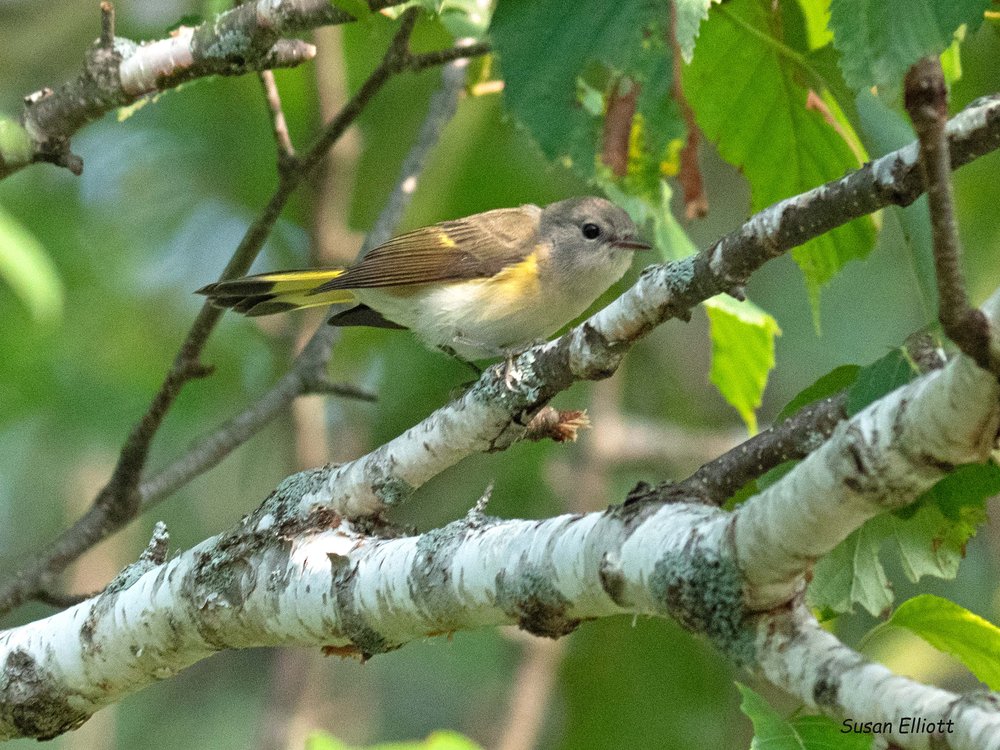 American RedstartThe cuckoos, heard everywhere earlier this year, were silent. One cuckoo, not identified to species, was seen briefly as it flew across the road.
American RedstartThe cuckoos, heard everywhere earlier this year, were silent. One cuckoo, not identified to species, was seen briefly as it flew across the road.
Numerous Red-eyed Vireos were heard, but no Warbling Vireos. A Yellow-throated Vireo, a species not often reported on this walk, was heard along Whipple Hollow Road near the intersection with Water Street.
It was a relief to get on to the new Whipple Hollow Trail, into the woods on the first half at least, and out of the sun and heat. It was somewhat quiet, however. Only one Northern Waterthrush sang compared to the six or so heard earlier in the season. A Pine Warbler was singing in the white pines in the stretch between boardwalks. The Sedge Wren seen in the meadow since late May was not observed although there have been several reports this week.
Other warbler species than mentioned above included Ovenbird, Black-and-white Warbler, Yellow Warbler, Chestnut-sided Warbler and a good number of Common Yellowthroat (24!)
A trip report of all the species seen can be found here.
The next walk is scheduled for Saturday, August 13, 7 a.m.
West Rutland Marsh - June 2022
 Eastern KingbirdFourteen participants joined RCAS’s June walk around West Rutland Marsh. As expected, the birds were busy with nesting activities with several species seen carrying food and young making their first public appearances. Some species were in full song, but others are quieter than the previous month.
Eastern KingbirdFourteen participants joined RCAS’s June walk around West Rutland Marsh. As expected, the birds were busy with nesting activities with several species seen carrying food and young making their first public appearances. Some species were in full song, but others are quieter than the previous month.
A Wilson’s Snipe was heard winnowing above Pleasant Street, somewhat surprising in the bright sun. Two Green Herons and one Great Blue Heron were seen while some of the other marsh residents such as Virginia Rail and American Bittern were not noted.
A high number of cuckoos, both Black-billed and Yellow-billed seen or heard and two more brief flyovers not identified to species.
Raptors included Osprey, Broad-winged Hawk and Red-tailed Hawk.
Woodpeckers were well represented with all the expected species: Yellow-bellied Sapsucker, Northern Flicker and Red-bellied, Downy, Hairy and Pileated woodpeckers.
Aside from several Eastern Kingbirds, flycatcher numbers were rather low although all the expected species were noted: Alder, Willow, and Least Flycatchers along with only one Eastern Phoebe.
The Whipple Hollow Trail produced several warbler species, Ovenbird, Northern Waterthrush, Nashville Warbler, Common Yellowthroat, American Redstart, Chestnut-sided Warbler, Pine Warbler and Canada Warbler.
Elsewhere on the trip Yellow Warbler, Black-and-white Warbler, Yellow-rumped Warbler and more Ovenbirds, Common Yellowthroats, American Redstarts and Chestnut-sided Warblers rounded out the warbler contingent.
Also along the Whipple Hollow Trail, Sedge Wrens, a rare Vermont bird, were heard calling and singing and also seen briefly.
Marsh Wrens and Swamp Sparrows are still singing away. Several Veerys were heard along the route as well. A Field Sparrow as singing up in the meadows east of Marble Street.
A full list of the birds seen can be found here.
Our next marsh walk is scheduled for Thursday, July 21, at 7 a.m.
Century Count XVII
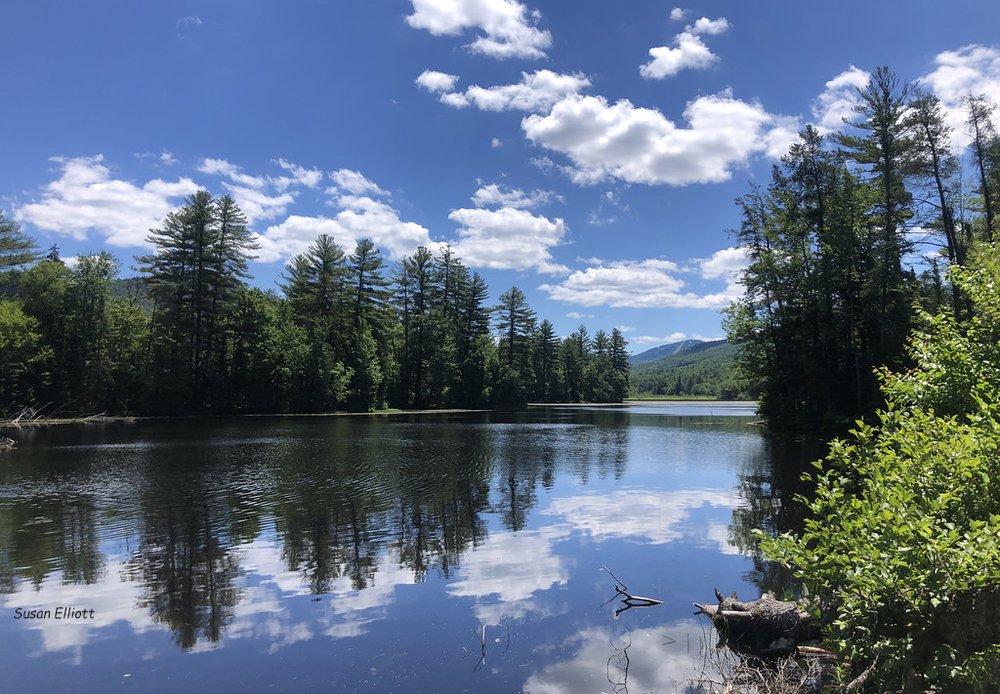 How many species can you find in Rutland County in one day? If it’s May, the weather is good and you have teams out scouring a good portion of the county, at least 120!
How many species can you find in Rutland County in one day? If it’s May, the weather is good and you have teams out scouring a good portion of the county, at least 120!
On May 21 RCAS held annual Century Count XXVII. With the Covid pandemic still with us, we again divided into teams. This allowed us to cover a wide variety of habitats from marsh to forest to lakeshores to fields and power lines.
Each team had highlights and also found species other teams missed. The big find of the day was a yellow-breasted chat at the Buckner Preserve in West Haven.
A flock of 55 pine siskins, a species we associate with winter, were at a feeder in Shrewsbury.
It’s shaping up to be a big cuckoo year – both black-billed and yellow-billed cuckoos were seen at quite a few locations.
With warbler migration winding down, most warbler species were seen with the exception of Cape May warbler and bay-breasted warbler, which may be at the tail end of their migration through our area. The ‘winged’ warblers, golden-winged and blue-winged and their hybrids including the ‘Lawrence’s’ hybrid were seen.
Some of the birding hotspots covered included the Buckner Preserve, Cogman/Ghost Hollow Roads in West Haven, West Rutland Marsh (including the new Whipple Hollow Trail), the Pleasant Street power line, Bomoseen State Park and the lake, Lefferts Pond and Kent Pond among others.
Many thanks to all who participated and submitted all their sightings to eBird!
Link to the eBird trip report, click here.
The List:
| Canada Goose Wood Duck Mallard Hooded Merganser Common Merganser Wild Turkey Ruffed Grouse Rock Pigeon Mourning Dove Yellow-billed Cuckoo Black-billed Cuckoo Chimney Swift Ruby-throated Hummingbird Virginia Rail Common Gallinule Killdeer American Woodcock Wilson's Snipe Spotted Sandpiper Ring-billed Gull Common Loon Great Blue Heron Green Heron Turkey Vulture Osprey Bald Eagle Broad-winged Hawk Red-tailed Hawk Barred Owl Belted Kingfisher Yellow-bellied Sapsucker Red-bellied Woodpecker Downy Woodpecker Hairy Woodpecker Pileated Woodpecker Northern Flicker | Peregrine Falcon Eastern Wood-Pewee Alder Flycatcher Willow Flycatcher Least Flycatcher Eastern Phoebe Great Crested Flycatcher Eastern Kingbird Yellow-throated Vireo Blue-headed Vireo Warbling Vireo Red-eyed Vireo Blue Jay American Crow Common Raven Black-capped Chickadee Tufted Titmouse Northern Rough-winged Swallow Tree Swallow Barn Swallow Red-breasted Nuthatch White-breasted Nuthatch Brown Creeper House Wren Winter Wren Marsh Wren Carolina Wren European Starling Gray Catbird Brown Thrasher Eastern Bluebird Veery Swainson's Thrush Hermit Thrush Wood Thrush American Robin Cedar Waxwing | House Sparrow House Finch Purple Finch Pine Siskin American Goldfinch Chipping Sparrow Field Sparrow White-throated Sparrow Savannah Sparrow Song Sparrow Swamp Sparrow Eastern Towhee Yellow-breasted Chat Bobolink Eastern Meadowlark Orchard Oriole Baltimore Oriole Red-winged Blackbird Brown-headed Cowbird Common Grackle Ovenbird Louisiana Waterthrush Northern Waterthrush Golden-winged Warbler Blue-winged Warbler Black-and-white Warbler Tennessee Warbler Nashville Warbler Mourning Warbler Common Yellowthroat American Redstart Northern Parula Magnolia Warbler Blackburnian Warbler Yellow Warbler Chestnut-sided Warbler Blackpoll Warbler Black-throated Blue Warbler Pine Warbler Yellow-rumped Warbler Prairie Warbler Black-throated Green Warbler Canada Warbler Scarlet Tanager Northern Cardinal Rose-breasted Grosbeak Indigo Bunting |
Whipple Hollow Trail
West Rutland Marsh - February 2022
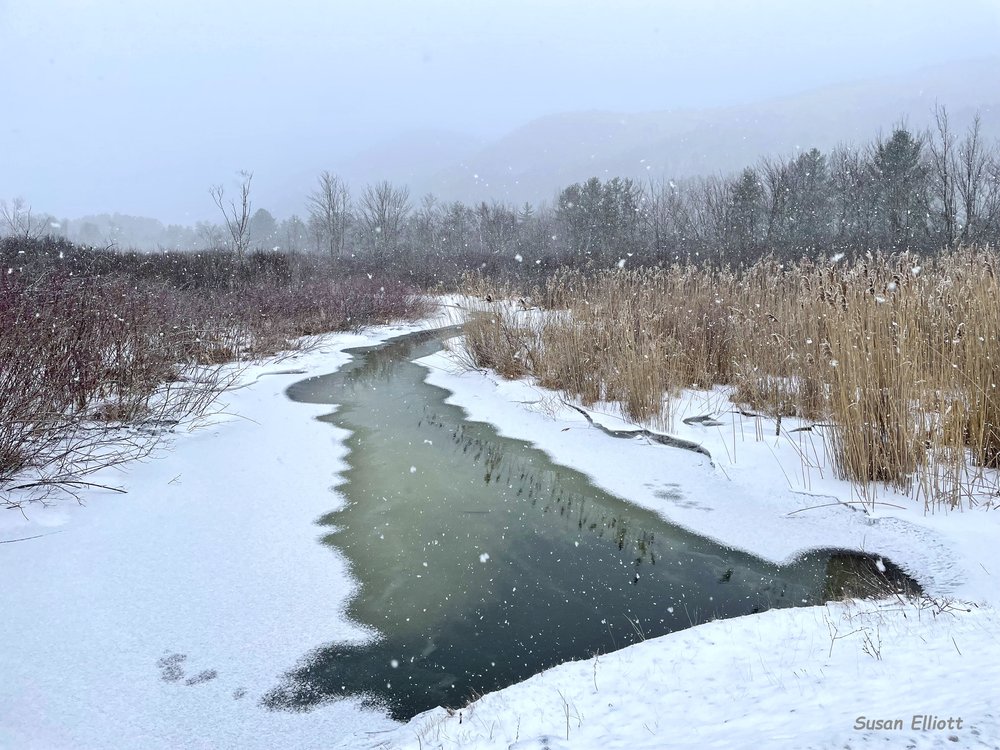
Five participants joined RCAS’s monthly walk around West Rutland Marsh, the walk scheduled to coincide with the annual Great Backyard Bird Count. Snow fell non-stop throughout the walk, somewhat limiting visibility, but overall, the weather was not bad for February with little wind and the temperature in the mid-20s.
Nineteen species were tallied in all. This compares to 15 one year ago and 18 for our February average.

Not surprisingly, many of the species were seen near the feeders by the Marble Street boardwalk. Several American tree sparrows and black-capped chickadees were joined by a blue jay, a purple finch, mourning doves and a downy woodpecker among others.
A flock of American robins, a species being seen in good numbers throughout the state this winter, was flying back and forth over Marble Street
The only raptor for the day was a red-tailed hawk and, while crows were numerous, only one common raven was heard.
The walk along the new Whipple Hollow Trail was pretty in the snow, but otherwise quiet except for a chickadee and a few goldfinches.
Upon our return to the feeders, a single common redpoll was feasting on seed. Redpolls made a sudden appearance in the state the day before so it was good to have one included on our walk.
Our next walk is scheduled for Saturday, March 19, at 8 a.m.
The list:
Mourning Dove 8
Red-tailed Hawk 1
Downy Woodpecker 3
Hairy Woodpecker 1
Blue Jay 14
American Crow 15
Common Raven 1
Black-capped Chickadee 26
Tufted Titmouse 3
White-breasted Nuthatch 6
Eastern Bluebird 1
American Robin 16
Purple Finch 1
Common Redpoll 1
American Goldfinch 38
American Tree Sparrow 7
Dark-eyed Junco (Slate-colored) 17
White-throated Sparrow 1
Northern Cardinal 10
West Rutland Marsh - January 2022
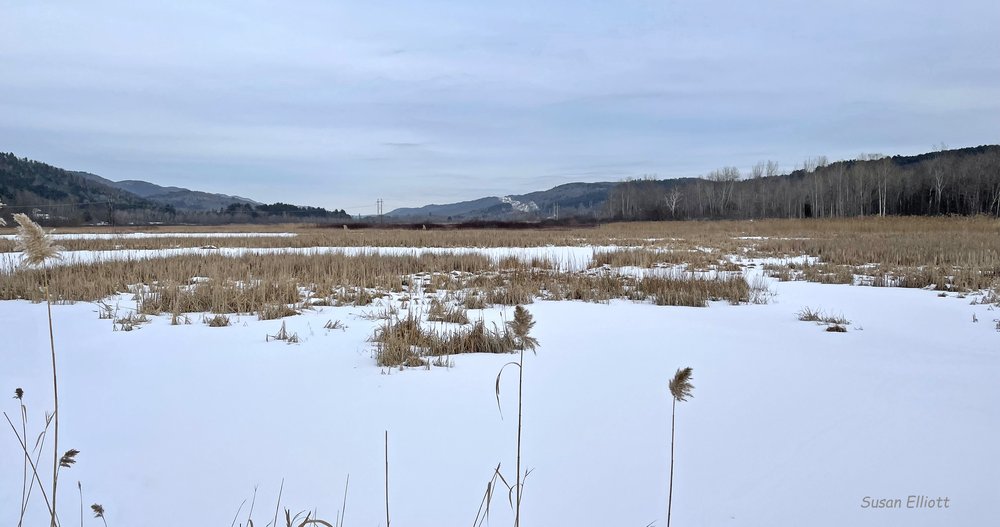 Robin was the word of the day for January’s monitoring of West Rutland Marsh! Of the 20 species tallied, American robins were the most abundant with about 130 in all, some in sizable flocks. But, no, it did not feel, like spring was in the air.
Robin was the word of the day for January’s monitoring of West Rutland Marsh! Of the 20 species tallied, American robins were the most abundant with about 130 in all, some in sizable flocks. But, no, it did not feel, like spring was in the air.
The day started at minus 8 degrees, but sunshine and no wind, made it almost bearable. The eight participants managed to keep warm by being bundled up in everything they own and walking briskly in spots where no birds were to be seen.
Twenty species is the same number we saw a year ago and one less than our average for the month of January.
No raptors were seen, but one red-tailed hawk was heard. Three woodpeckers, either downy or hairy, were drumming. Though not in full song, birds were more vocal than they were on our December walk no doubt in response to the longer days (though certainly not the temperature!).
Our next walk is scheduled for Saturday, February 19, at 8 a.m. That count is scheduled to coincide with the Great Backyard Bird Count.
The list:





